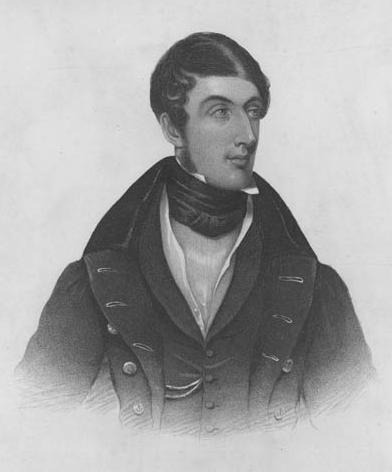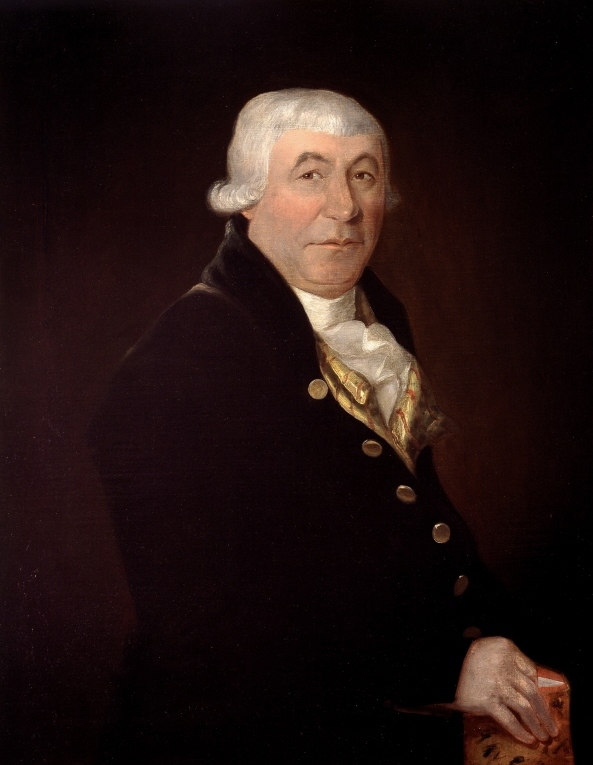|
George Moffatt (1787-1865)
George Moffatt (August 13, 1787 – February 25, 1865) was a businessman and political figure in Lower Canada and Canada East (now Quebec). Born in England, he emigrated to Lower Canada at the age of 14. He became involved in business in Montreal, including the fur trade. Moffatt was involved in the municipal politics of Montreal, and in 1830 was appointed to the Legislative Council of Lower Canada. Following the Lower Canada Rebellion of 1837–1838, he was appointed to the Executive Council of Lower Canada and the Special Council of Lower Canada, an appointed body that took the place of the Parliament of Lower Canada, which was suspended. He provided advice to the Governor General, Lord Durham, on the constitutional reforms following the Rebellion, and supported the union of Lower Canada and Upper Canada. He also urged moderation after the Rebellion, suggesting to the Colonial Secretary that banishment for the most serious rebels was the appropriate penalty. After t ... [...More Info...] [...Related Items...] OR: [Wikipedia] [Google] [Baidu] |
Legislative Council Of Lower Canada
The Legislative Council of Lower Canada was the upper house of the Parliament of Lower Canada from 1792 until 1838. The Legislative Council consisted of appointed councillors who voted on bills passed up by the Legislative Assembly of Lower Canada. The legislative council was created by the '' Constitutional Act''. Many of the members first called in the Council in 1792 had served as councillors in the Council for the Affairs of the Province of Quebec. The council came to be dominated by the Château Clique, members of the province's most powerful families who were generally interested in preserving the status quo. Both the upper and lower houses were dissolved on March 27, 1838 following the Lower Canada Rebellion and Lower Canada was administered by an appointed Special Council. Following the Act of Union in 1840, the Legislative Council of the Province of Canada was created in 1841. Legislative buildings * Old Parliament Building (Quebec) Old Parliament Building (Quebe ... [...More Info...] [...Related Items...] OR: [Wikipedia] [Google] [Baidu] |
Canada East
Canada East () was the northeastern portion of the Province of Canada. Lord Durham's Report investigating the causes of the Upper and Lower Canada Rebellions recommended merging those two colonies. The new colony, known as the Province of Canada, was created by the Act of Union 1840 passed by the Parliament of the United Kingdom, having effect in 1841. For administrative purposes, the new Province was subdivided into Canada West and Canada East. The former name of "Lower Canada" came back into official use in 1849, and as of Canadian Confederation of 1867 it formed the newly created province of Quebec. An estimated 890,000 people lived in Canada East in 1851. Geography It consisted of the southern portion of the modern-day Canadian province of Quebec. It was a former British colony called the Province of Lower Canada. Based on Lord Durham's report it was merged with the Province of Upper Canada (present-day southern portion of the Province of Ontario) to create the Provi ... [...More Info...] [...Related Items...] OR: [Wikipedia] [Google] [Baidu] |
London
London is the Capital city, capital and List of urban areas in the United Kingdom, largest city of both England and the United Kingdom, with a population of in . London metropolitan area, Its wider metropolitan area is the largest in Western Europe, with a population of 14.9 million. London stands on the River Thames in southeast England, at the head of a tidal estuary down to the North Sea, and has been a major settlement for nearly 2,000 years. Its ancient core and financial centre, the City of London, was founded by the Roman Empire, Romans as Londinium and has retained its medieval boundaries. The City of Westminster, to the west of the City of London, has been the centuries-long host of Government of the United Kingdom, the national government and Parliament of the United Kingdom, parliament. London grew rapidly 19th-century London, in the 19th century, becoming the world's List of largest cities throughout history, largest city at the time. Since the 19th cen ... [...More Info...] [...Related Items...] OR: [Wikipedia] [Google] [Baidu] |
England
England is a Countries of the United Kingdom, country that is part of the United Kingdom. It is located on the island of Great Britain, of which it covers about 62%, and List of islands of England, more than 100 smaller adjacent islands. It shares Anglo-Scottish border, a land border with Scotland to the north and England–Wales border, another land border with Wales to the west, and is otherwise surrounded by the North Sea to the east, the English Channel to the south, the Celtic Sea to the south-west, and the Irish Sea to the west. Continental Europe lies to the south-east, and Ireland to the west. At the 2021 United Kingdom census, 2021 census, the population was 56,490,048. London is both List of urban areas in the United Kingdom, the largest city and the Capital city, capital. The area now called England was first inhabited by modern humans during the Upper Paleolithic. It takes its name from the Angles (tribe), Angles, a Germanic peoples, Germanic tribe who settled du ... [...More Info...] [...Related Items...] OR: [Wikipedia] [Google] [Baidu] |
Montreal Annexation Manifesto
The Montreal Annexation Manifesto was a political document dated September 14, 1849, and signed in Montreal, Canada East, calling for the Province of Canada's annexation by the United States. The manifesto was published in two versions (October 11, 1849, and December 1849) by the ''Annexation Association'', an alliance of 325 Montreal businessmen. Most of these were English-speaking Conservative Party of Canada (historical), Tories, who were opposed to United Kingdom, Britain's abolition of the Corn Laws, which ended preferential colonial trade, and by its consent to the Rebellion Losses Bill, and French Canadian nationalists (including Louis-Joseph Papineau) who supported the republican system of government in the United States. These businessmen believed that so long as Canada was under British rule, it would be subjected to the interests of elements of Britain's aristocracy and businessmen. Papineau too had believed a similar subjection occurred, perpetrated by France. The signat ... [...More Info...] [...Related Items...] OR: [Wikipedia] [Google] [Baidu] |
Rebellion Losses Bill
The Rebellion Losses Bill (full name: ''An Act to provide for the Indemnification of Parties in Lower Canada whose Property was destroyed during the Rebellion in the years 1837 and 1838'') was a controversial law enacted by the legislature of the Province of Canada in 1849. Its passage and subsequent royal assent, this being an affirmation of responsible government in the colony, by the Governor General, James Bruce, 8th Earl of Elgin makes the bill a landmark piece of legislation in Canadian political history. The bill was enacted to compensate Lower Canadians who lost property during the Rebellions of 1837 with measures similar to those providing compensation in Upper Canada. Two factors made this measure controversial. Even though participants in the Rebellion could not be compensated with taxpayer's money, sympathy for the Rebellion was more widespread in Lower Canada so that compensation in Lower Canada was seen as "giving money to the rebels". Secondly, the damage done ... [...More Info...] [...Related Items...] OR: [Wikipedia] [Google] [Baidu] |
Act Of Union 1840
The ''British North America Act, 1840'' ( 3 & 4 Vict. c. 35), also known as the ''Act of Union 1840'', () was approved by Parliament in July 1840 and proclaimed February 10, 1841, in Montreal. It abolished the legislatures of Lower Canada and Upper Canada and established a new political entity, the Province of Canada to replace them. Background Rebellion of Lower Canada After the War of 1812, the elected assembly of Lower Canada was dominated by French Canadians. A strong sense of nationalism sprang up among the francophones living in Lower Canada. The nationalists were led by Louis-Joseph Papineau, who was a part of what would later be known as the Patriot Party. One of its biggest demands was to determine how the colony's revenue would be spent. It challenged the authority of the upper house of the legislature. As well, the party sought to take control of civil services such as the executive council, which advised the sitting governor-general. All the demands were re ... [...More Info...] [...Related Items...] OR: [Wikipedia] [Google] [Baidu] |
Château Clique
Lower Canada Tories is a general name for individuals and parliamentary groups in Lower Canada, and later in the Province of Canada's division of Canada East, who supported the British connection, colonialism, and a strong colonial governor. They generally favoured assimilation of French-Canadians to British culture, laws, and the English language, and opposed democracy. Château Clique The Château Clique, or ', was a group of wealthy families in Lower Canada in the early 19th century. They were the Lower Canada equivalent of the Family Compact in Upper Canada. Like the Family Compact, the Château Clique gained most of its influence after the War of 1812. Most of its families were British merchants, but some were French Canadian seigneurs who felt that their own interests were best served by an affiliation with this group. Some of the most prominent members were brewer John Molson and James McGill, the founder of McGill University. Generally, they wanted the French Ca ... [...More Info...] [...Related Items...] OR: [Wikipedia] [Google] [Baidu] |
Kingston, Ontario
Kingston is a city in Ontario, Canada, on the northeastern end of Lake Ontario. It is at the beginning of the St. Lawrence River and at the mouth of the Cataraqui River, the south end of the Rideau Canal. Kingston is near the Thousand Islands, a tourist region to the east, and the Prince Edward County, Ontario, Prince Edward County tourist region to the west. Kingston is nicknamed the "Limestone City" because it has many heritage buildings constructed using local limestone. Growing European exploration in the 17th century and the desire for the Europeans to establish a presence close to local Native occupants to control trade led to the founding of a New France, French trading post and military fort at a site known as "Cataraqui" (generally pronounced ) in 1673. The outpost, called Fort Cataraqui, and later Fort Frontenac, became a focus for settlement. After the Conquest of New France (1759–1763), the site of Kingston was relinquished to the British. Cataraqui was renamed K ... [...More Info...] [...Related Items...] OR: [Wikipedia] [Google] [Baidu] |
Upper Canada
The Province of Upper Canada () was a Province, part of The Canadas, British Canada established in 1791 by the Kingdom of Great Britain, to govern the central third of the lands in British North America, formerly part of the Province of Quebec (1763–1791), Province of Quebec since 1763. Upper Canada included all of modern-day Southern Ontario and all those areas of Northern Ontario in the which had formed part of New France, essentially the watersheds of the Ottawa River or Lakes Lake Huron, Huron and Lake Superior, Superior, excluding any lands within the watershed of Hudson Bay. The "upper" prefix in the name reflects its geographic position along the Great Lakes, mostly above the headwaters of the Saint Lawrence River, contrasted with Lower Canada (present-day Quebec) to the northeast. Upper Canada was the primary destination of Loyalist (American Revolution), Loyalist refugees and settlers from the United States after the American Revolution, who often were granted la ... [...More Info...] [...Related Items...] OR: [Wikipedia] [Google] [Baidu] |





